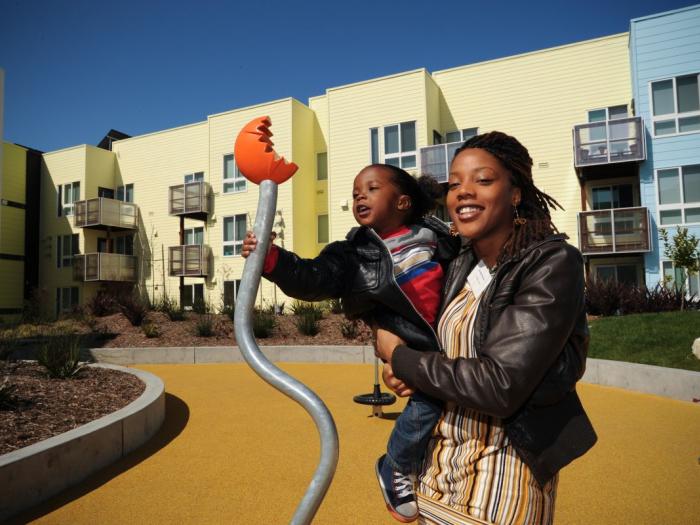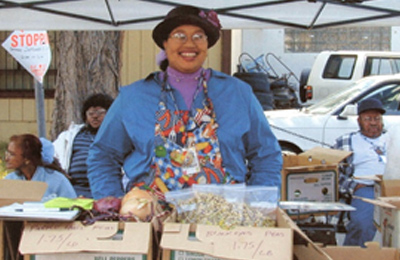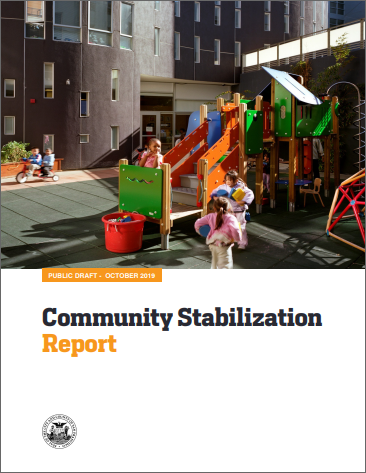
Community Stabilization
Learn about the City's existing policies and programs as well as ideas for future consideration with our interactive website and toolkit, which provides a starting point for agencies, decision-makers, and community members to explore stabilization efforts and identify critical pathways forward.
Community Stabilization Report
Read the Public Report and the Executive Summary
中文 | Español | Filipino
Draft Policy and Program Inventory
San Francisco is experiencing increasing income inequality, population growth tied to economic growth, and a lack of affordable housing. These realities are leading to a loss of the middle class and displacement for many communities while the economy booms for others. Housing stock has not kept pace with job growth, pushing prices up for a limited supply of units.
On many fronts, the City is working to address the detrimental impacts of displacement pressures on vulnerable populations and businesses. Yet, the scale of the current challenge is such that the City must expand its efforts to meet the need.
What is the Community Stabilization initiative?
The Community Stabilization initiative is a multi-agency effort to assess the City’s existing portfolio of tools, unify fragmented efforts into one comprehensive inventory, and identify priorities for the future.
The initiative seeks to mitigate the impacts of ongoing displacement and help vulnerable populations thrive and contribute to the City’s economy and culture. It enables decision-makers to make strategic choices and support interagency coordination to help stabilize our vulnerable populations.
How Are We Defining Key Terms?
Displacement – The process by which a household is forced to move from residence—or is prevented from moving into a neighborhood that was previously accessible to them because of conditions beyond their control (UC Berkeley Urban Displacement Project, 2018).
Vulnerable Populations – For the purpose of this report, vulnerable populations refer to categories of people who are at higher risk of displacement after eviction due to individual and institutional barriers to acquiring market-rate housing. The vulnerable populations included in this report are not an exhaustive list of all categories of people at higher risk but are based on self-identified data in the qualifying documents for inclusion in the Small Sites Program. The categories are Senior (65+ years of age), Disabled, Families with children, Black/African-American, Latinx/Hispanic, Asian, and Pacific Islander. These categories were identified because these groups of people experience disproportionate hardship after eviction (Desmond & Tolbert Kimbro, 2015; Desmond, 2013, 2012).
Project Documents
- Public Report (May 2020)
- Planning Commission – October 17, 2019
- SPUR presentation
Do you have 6 minutes and 40 seconds? Watch the video of the Community Stabilization Strategy presentation given at SPUR or view the presentation slide deck. (powerpoint) - Planning Commission – October 11, 2018
Links
- UC Berkeley's Urban Displacement Project
The Urban Displacement Project is a research and action initiative that aims to understand the nature of gentrification and displacement in the Bay Area, Southern California and Portland. - Housing Affordability Strategy
The Housing Affordability Strategy will provide a framework to help City staff, policymakers, and the public evaluate how our housing policies and plans work together to address housing affordability for our diverse population. - Mission Action Plan 2020
The Mission Action Plan 2020 seeks to retain low to moderate income residents and community-serving businesses (including Production, Distribution and Repair), artists, and nonprofits in order to strengthen and preserve the socioeconomic diversity of the Mission neighborhood. - Sustainable Chinatown
Sustainable Chinatown aims to protect the elements that make the Chinatown neighborhood unique while addressing its most serious challenges. - Tenderloin Development Without Displacement
The Tenderloin Development without Displacement Initiative (TLDWDI) is a community planning effort lead by seven Tenderloin anchor institutions, Tenderloin residents, and the San Francisco Planning Department. TLDWDI formed in response to the displacement of low income people from the Tenderloin neighborhood.
Step 1
Data review and analysis – In this first step, the Department coordinated with UC Berkeley’s Urban Displacement Project, the U.S. Census, and other City data sources to compile and analyze information to better understand displacement pressures within San Francisco’s neighborhoods. This information was presented to the Planning Commission on October 11, 2018.
Step 2
Compile and assess the City's existing stabilization and displacement prevention programs and policies and identify priorities – City agencies and community experts helped to assess the City’s tenant protections and housing stabilization, housing production and preservation, cultural stabilization, and economic development efforts. Key trends, benefits, issues, and ideas for consideration to enhance their purpose and reach are included in the inventory. Based on community input and in close coordination with City agencies and the Mayor’s Office, key priorities were identified that will strengthen the City’s community stabilization efforts.
Community Organizations & Stakeholders
 We have engaged with numerous community organizations and stakeholders to understand what issues they face and assess programs they manage or use. A list of community organizations and stakeholders, and meetings with community organizations is available below:
We have engaged with numerous community organizations and stakeholders to understand what issues they face and assess programs they manage or use. A list of community organizations and stakeholders, and meetings with community organizations is available below:
- AGI Avant
- ASIAN Inc.
- BALANCE
- Bentall Kennedy
- Bonnewit Development Services
- BRIDGE Housing
- Central City SRO Collaborative
- Chinatown Community Development Center (CCDC)
- Chinatown SRO Collaborative
- Council of Community Housing Organizations (CCHO)
- Dolores Street Community Services
- Enterprise Opportunity Council
- Episcopal Community Services
- Glide Foundation
- Haight Street Neighborhood Association
- Homeownership SF
- Housing Rights Committee
- Market Street for the Masses
- Mercy Housing California
- Mission Economic Development Association (MEDA)
- Mission Housing Development Corporation
- Mission SRO Collaborative
- Presidio Bay Ventures
- PODER
- REDF
- San Francisco Apartment Association
- San Francisco Housing Action Coalition (SFHAC)
- San Francisco Housing Development Corporation (SFHDC)
- Senior and Disability Action
- SF Community Land Trust
- SF Foundation
- SF LGBT Center
- Share Better SF
- SPUR
- SRO United Families Collaborative
- Tenants Union
- Tenderloin Housing Clinic
- Tenderloin Neighborhood Development Corporation (TNDC)
- Tenderloin People's Congress
- TODCO
- Young Community Developers
- Youth Community Center
Meetings Held with Community Organizations
| Topic | Community Stakeholders | Date |
| 100% Affordable Housing Program | Bonnewit Development Services BRIDGE Housing Mercy Housing California San Francisco Housing Action Coalition Mission Housing Development Corporation Tenderloin Neighborhood Development Corporation Episcopal Community Services Young Community Developers |
March 26, 2019 |
| Project Introduction | SF Foundation |
January 23, 2018 |
| Tenant Protections | MOHCD Housing Counseling Working Group | February 26, 2018 March 1, 2019 |
| SRO Protections | Chinatown SRO Collaborative Tenderloin Neighborhood Development Corporation (TNDC) Senior and Disability Action SRO United Families Collaborative Mission SRO Collaborative Glide Foundation Faithful Fools Market Street for the Masses |
May 29, 2018 September 25, 2018 |
| Small Sites Program | CCDC CCHO MEDA SF Community Land Trust Mission Housing Development Corporation |
June 29, 2018 |
| Homeownership Stabilization and Empowerment Programs | Homeownership SF San Francisco Housing Development Corporation MEDA ASIAN Inc. BALANCE SF LGBT Center CCHO |
October 24, 2018 |
| Short-Term Rentals |
Unite Here 2 |
December 6, 2018 December 19, 2018 |
| Lottery Preference Program |
CCDC |
December 19, 2018 |
| Inclusionary Housing |
CCDC Presidio Bay Ventures |
February 27, 2019 |
| Summer/Fall 2017 | Urban Displacement Project update |
| Winter 2017 | Draft Existing City Programs and Policies Toolkit |
| Spring/Summer 2018 | City Agency and Community Stakeholder Meeting |
| Summer/Fall 2018 | Program and Policy Assessment |
| Fall 2018 | Planning Commission Informational Presentation |
| Winter 2018/Spring 2019 | Policy and Program Inventory City Agency and Community Stakeholder Meetings |
| Summer/Fall 2019 | Policy and Program Inventory and Priorities City Agency and Community Stakeholder Meetings |
| Fall 2019 | Planning Commission Informational Presentation of Public Draft |
| Fall/Winter 2019 | Refine Community Stabilization Public Draft City Agency and Community Stakeholder Meetings |
| Winter 2019 | Final Community Stabilization Policy and Program Inventory and Priorities |
Planning Department
Carla de Mesa
Senior Community Development Specialist
carla.demesa@sfgov.org
Partners
We are working with City agencies that manage and administer funding for community stabilization programs. These include: Mayor's Office of Housing and Community Development (MOHCD), Office of Economic and Workforce Development (OEWD), Department of Public Health, Rent Board, Department of Building Inspection, Human Rights Commission, Small Business Commission, HOPESF, Human Services Agency, Arts Commission, and Housing Authority.



